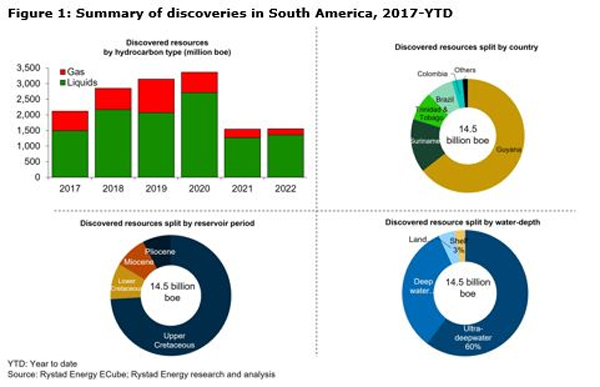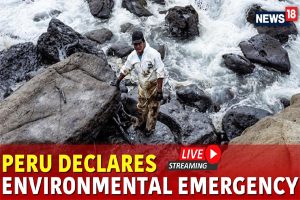
Renay Sambach, Kaieteur News
GEORGETOWN
EnergiesNet.com 07 12 2022
South America has taken the exploration crown for discovered volumes of crude oil and the continent is set to remain a global exploration hot spot for the next two years, with Guyana taking the lead with a plethora of oil and gas resources already proven and drilling campaigns underway.
This is according to Rystad Energy, a Norwegian independent energy research and business intelligence company that provides data, tools, analytics, and consultancy services to the global energy industry.
Reporting on Latin America’s Regional Insights for June 2022, Rystad documented that South America’s position is driven primarily by activity in Guyana, Brazil, Suriname, and Colombia.
Additionally, the increase in the offshore well count in the region is expected to be led by Guyana, followed by Brazil and Colombia, while onshore exploration, which has taken a back seat in the past two years, is on track for a comeback this year and in 2023.
Following the slump as a result of the COVID-19 pandemic, which took hold in early 2020 and sent oil demand and prices tumbling, the region has seen a recovery in activity this year.
According to Rystad, an analysis of the period from 2017 to 2022 revealed that South America takes the top spot among all continents in terms of discovered hydrocarbons.
The positioning is mainly attributed to Guyana which takes the top spot in the region due to the plethora of finds by American oil giant, ExxonMobil subsidiary, Esso Exploration and Production Guyana Limited (EEPGL), on the prolific Stabroek Block which spans more than six million acres in the country’s Exclusive Economic Zone (EEZ).
EEPGL is the operator of the country’s richest oil block which is estimated to hold nearly 11 billion barrels of equivalent of oil (beo). The block is being developed by EEPGL which holds a 45 percent stake, Hess Guyana Exploration Limited with a 30 percent share, and CNOOC Petroleum Guyana Limited holding the remaining 25 percent.
According to Rystad, the Region has already seen close to 14.5 billion barrels of discovered resources in the 2017 to 2022 period, of which Guyana accounts for 65 per cent, followed by Suriname with 15 per cent.
Moreover, the Guyana-Suriname Basin continues to be an exploration hot spot in the region and has taken center stage since the breakthrough 2015 Liza discovery on the Stabroek Block, which de-risked the basin. Notably, since 2021, 86 per cent of all the discovered resources in the region lie in Guyana and Suriname.
It was highlighted that in less than six months of 2022, the region has already discovered hydrocarbon volumes close to the total unearthed during the whole of 2021.
Some of the major discoveries in the region include the Whiptail, Cataback and Pinktail find on Stabroek, which together added 1 billion barrels of reserves – other major discoveries in the region in 2021 were Keskesi East, discovered by Total Energies off Suriname, and the Urissane discovery made by Petrobras off Brazil.
Guyana’s made five discoveries for 2022 in the Stabroek Block, which allowed the country to garner another title. As Russia takes the lead for the largest discovered volumes of oil and gas resources since 2015, positioning second is Guyana, which is followed by the United States of America (USA).
Presently, Exxon is engaged in an aggressive 25-well exploration campaign that began back in June of last year. That drilling campaign is expected to last until the end of 2025. This is in addition to a separate 12-well campaign that had begun back in December 2020 in the Stabroek Block and ended earlier in 2021.
Outside of the loaded Stabroek Block, Exxon is also engaging the Environmental Protection Agency (EPA) to commence two separate 12-well drilling campaigns in the Canje and Kaieteur oil blocks.
For the Canje Block, Exxon is hoping to commence its drilling campaign in the fourth quarter of this year and wrap up in the first quarter of 2025. The Canje Block is located offshore, in deepwater of Guyana, southeast of the Kaieteur Block, and north-northeast of the Stabroek Block. Meanwhile for the Kaieteur Block, this exercise, once approved, would start in 2022 or 2023 and conclude by the first quarter of 2027. The Kaieteur Block, which spans 13,500 km2, holds a gross, estimated prospective resource of over 2.1 billion barrels of crude.
For its part, Total Energies’ Block 58 across the border in Suriname, added 250 million barrels and Petrobras earlier this year drilled three wells in Brazil’s pre-salt polygon. The state-owned giant announced the presence of hydrocarbons at its Curacao well drilled on its Aram Block in the pre-salt Santos Basin and announced an oil discovery at its Alto de Cabo Frio Central Noroeste well on its Alto de Cabo Frio Central Block in the pre-salt Campos Basin. Petrobras plans to drill appraisal wells at both these finds later in the year.
kaieteurnewsonline.com 07 12 2022












